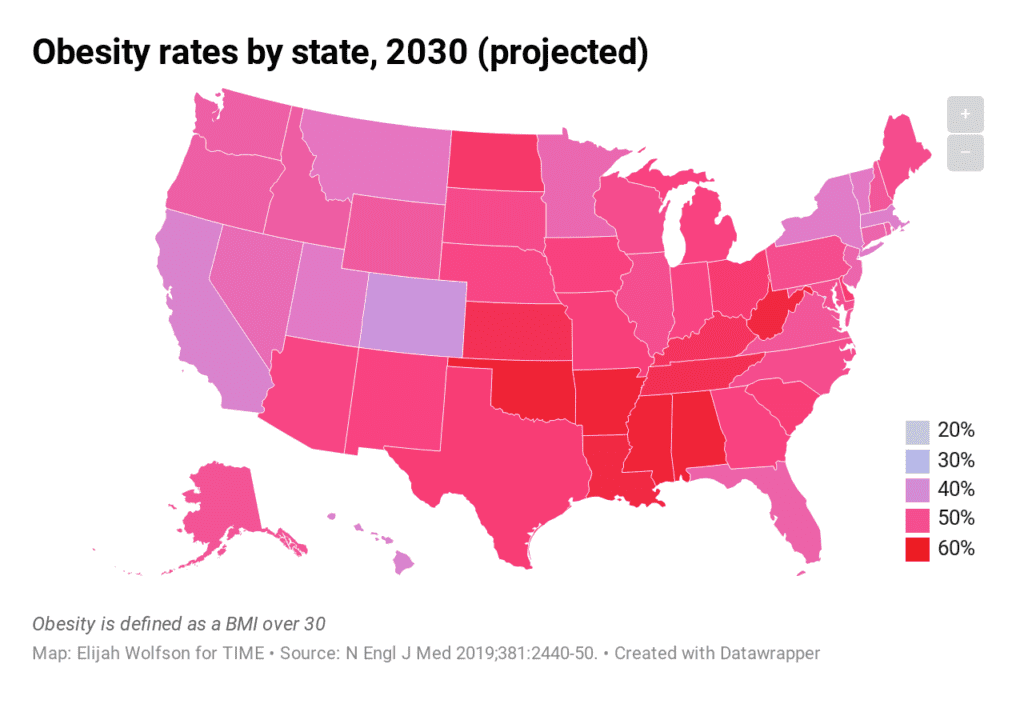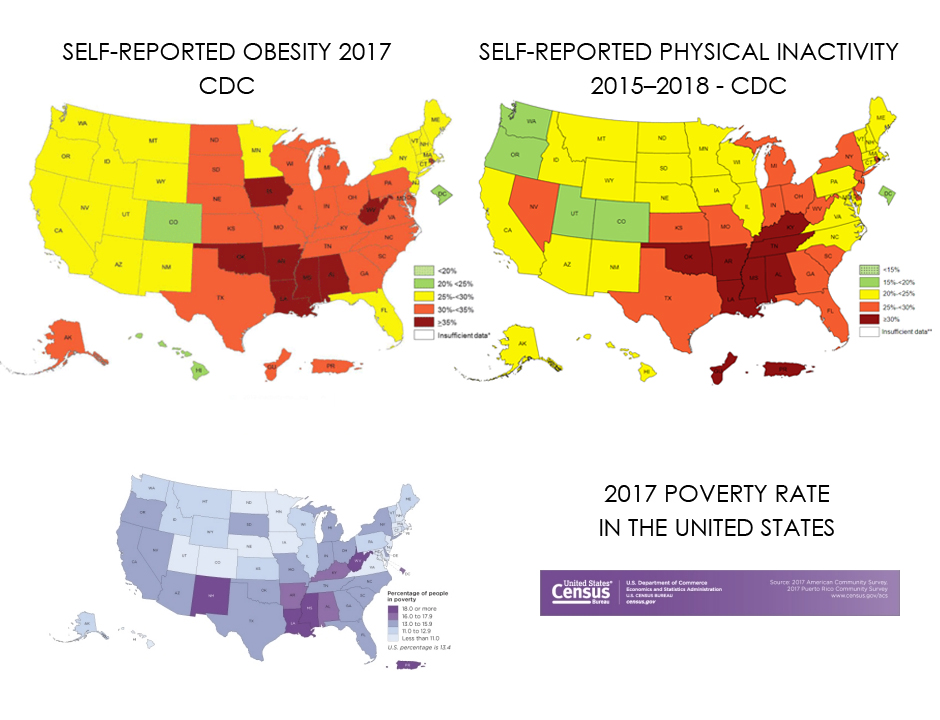The Rise of Obesity – It’s Complicated.
Does the previous picture look good to you? You’re not alone. And you are not alone in what it can do to your body.
If we eat this type of food too often, it can lead to all sorts of issues ranging from obesity and chronic diseases like cardiovascular disease, type 2 diabetes, and non-alcoholic fatty liver disease. Obesity is an increasing problem in this country. Of that, there is no denying. For reference, review the following.

It is interesting to see that while the South (and SouthEast) are heavily impacted. Many do not know that obesity is increasing across the board and that, over time, other states and regions are increasing their rates. Using logic, cause, and effect, and Occam’s Razor as a guide, I want you to consider the following.
Over the course of six years (from 1985 to 1990), there was a steady rise in obesity across the United States in the 10-14% range, which means that 10-14% of the population was obese. In 1991, we saw the first category of 15-19%. Six years later (1997), we saw the first category of greater than or equal to 20%. Four years later, we saw the first category of greater than or equal to 25%. Four years later, we saw the first category of greater than or equal to 30%. This is to say that not only is obesity rising in prevalence, but it’s also speeding up.
Flash-forward to today, and we see that several states have breached the >35% mark, and there are a couple of states on the verge of touching the 40% mark. Specifically, West Virginia (39.5%), Mississippi (39.5%), Arkansas (37.1%), Louisiana (36.8%), Kentucky (36.6%), Alabama (36.2%), Iowa (35.3%), North Dakota (35.1%), and Missouri (35.0%) (BRFSS,2020). I share this only to demonstrate that it’s not only a southern problem and that this issue continues to spiral out of control across the country. Of course, this contrasts with Colorado (23%), which has consistently been on the lower end of the scale. However, they are also increasing their numbers, so don’t let that fool you.
So why have some regions been impacted more than others? I’m not sure that’s a fair question because, clearly, everyone is affected – eventually. However, I have a theory. Perhaps being last has something to do with income and local cultures regarding activity or food choices, while being one of the first has to do with a lack of activity and increased poverty. But I also don’t see that any state has been able to “stabilize” its obesity rates because we continue to see a rise with these markers as we see a rise in inflation and dollar devaluation. Perhaps this is a clue.
Are obesity, inactivity, and poverty-related?

Based on my years of research, I blame several things. The first would have to be a reduction in buying power. Weird, right? Well, the less your dollar can buy, the worse your food selections will be – unless you are growing or raising your own. Similarly, the less money you have, the fewer leisure activities you may be able to engage in. So, for example, it would require extra money to buy a bike or a gym membership.
Second, and very much related to the first, is processed and convenience foods. This includes boxed foods, prepared foods, frozen foods, preservative-laced foods, fast foods, etc. Over the last 30 years, these foods have risen dramatically. Fewer are buying whole ingredients and preparing fresh meals on the regular.
Third, an increase in sedentary lifestyles is also to blame. Perhaps this is related to the first, but this issue also includes transitions from outdoor manual labor to white-collar jobs, less time to be active due to increased workloads, general fatigue, and poverty dependence. Ultimately, this one is rather simple; inactivity means fewer calories burned.
But an issue I haven’t seen much research on or talk about is the vicious circle that all this creates or comes about as a result. In other words, I don’t see many trying to connect the dots. To be clear, processed, prepped, boxed, and fast foods are usually filled with refined carbohydrates and are not nutrient-dense. This means that the body will likely not get everything it needs, making it hungry. Additionally, there will be an inflammatory spike and a quick spike in blood sugar due to the high level of refined carbs in those types of food. Match all this with a lack of activity, and we have a problem.
That is a perfect recipe for feeling even more tired and hungry – which likely results in higher calorie consumption and increased sedentary behavior. So it’s back to even more junk food and feeling like trash, and the cycle continues. This is ironic (in a sense) because instead of spending the extra money on more junk food to fill the void, one could potentially pay the money up-front to buy nutrient-dense foods that would help keep you full without eating so much, improve energy, and hence, help to break the cycle.
Regardless, and under the current situation, when it comes to cooking “good” food after a long day’s work, I cannot imagine many being up for it. Instead, they will choose more of the same garbage for the sake of convenience. When it comes to going outside and doing something active, those consuming such foods will be too tired and instead opt to sit down and recoup. Low-income people are in greater danger of this because (as we all know) junk food and fast food are marketed heavily toward kids and the poor because such foods are more affordable.
Of course, I supposed we could say that the price of “good” food would be an issue across the board – or will be. Unfortunately, due to a slew of reasons (inflation, taxation, dollar devaluation, etc.), people are not getting as much in their basket today as they did 30 or even ten years ago. As a result, decisions are made, and quality foods often take a back seat to cheaper foods.
I’m speculating, of course. However, it’s hard to ignore how these three ideas seemingly overlap. It’s also hard to ignore that as we see one issue rise, the others seem to follow. Is there a connection? I believe there is.
I used to think that several things could be done to fix this. Unfortunately, I’m unsure what can be done at this point. Out of education, regulating poor marketing practices, holding the food industry responsible for the hundreds of thousands of deaths associated with their foods, and ensuring the affordability of quality foods, the only idea anyone seems to want to get behind is education. But even that’s a problem because much of the information floating around out there is either nonsense or contradicts the science. Furthermore, the advice is often to talk to a medical doctor about nutrition – who is usually not trained in nutrition in the first place.
Not that it matters, education alone is not enough. This is because when it comes to nutrition education, there seems to be a substantial gap. For example, a survey conducted by Consumer Reports magazine found that 9 out of 10 Americans think they are eating better than they really are (Kaplan, 2011).
The fact is that many wouldn’t know “healthy” if it was shoved down their throats. For example, an NPR poll suggested that 75 percent of Americans say they eat healthily, but 71 percent of the public thinks granola bars are healthy (Aubrey & Godoy, 2016). That’s crazy! I suspect that this has much to do with advertising. Additionally, I saw that over a third of Americas consume fast food daily. Friends, this is not good.
Then you can factor in the ignorance surrounding terms like “gluten-free,” “diet,” “low-fat,” and “fat-free.” How many articles or reports must be written before people understand the truth about these foods? It’s not like the information isn’t available, and it’s not like people (like myself) haven’t been trying to get the word out. So then factor in the fad diets and the “fake health foods” like veggie chips, trail mix, juice, fruit smoothies, almond milk, energy bars, most yogurts, margarine, sports drinks, sugar substitutes, and so on, and you can see it’s a big fat mess. Literally.
We can clearly see that healthy eating is not the reality for most, even when they think they are eating well. We all must understand that unhealthy eating and a lack of physical activity are leading causes of death in the United States. The irony is that people are often afraid of the things that will likely NOT kill them (like sharks, bees, guns, etc.) Yet, many will get in their car and drive to a fast food joint without a second thought – because it’s cheap. This seems crazy to me, considering that an unhealthy diet contributes to approximately 678,000 deaths yearly (due to nutrition and obesity-related diseases, such as heart disease, cancer, and type 2 diabetes).
I don’t know what can be done about the nation as a whole, and this is especially true since our buying power (dollar) is eroding by the day and because so many are now highly reluctant to give up the foods they are seemingly addicted to. However, the way I see it, you can either invest in quality food, get a little exercise, and feel good now, or you can feel bad now and spend that money with the medical system later as you progressively feel worse.
My advice is simple. Save yourself and your family! Break the cycle by getting better foods and getting active. You’ll probably be spending the money either way, and something tells me that many more will have the extra time. So you might as well consider your food and activity an investment in yourself.
Did you enjoy this article? You might also like my article titled “Let’s Talk about Health Food.”
This article was written from a Health Science perspective. Dr. Robertson is a health researcher and educator, not a physician. The information provided here is not medical advice, a professional diagnosis, opinion, treatment, or service to you or any other individual. The information provided is for educational and anecdotal purposes only and is not a substitute for medical or professional care. You should not use the information in place of a visit, call consultation, or the advice of your physician or other healthcare providers. Dr. Robertson is not liable or responsible for any advice, course of treatment, diagnosis, or additional information, services, or product you obtain or utilize. IF YOU BELIEVE YOU HAVE A MEDICAL EMERGENCY, YOU SHOULD IMMEDIATELY CALL 911 OR YOUR PHYSICIAN.
RESOURCES
Aubrey, A., & Godoy, M. (2016, August 03). 75 Percent of Americans Say They Eat Healthy – Despite Evidence To The Contrary. Retrieved May 25, 2020, from https://www.npr.org/sections/thesalt/2016/08/03/487640479/75-percent-of-americans-say-they-eat-healthy-despite-evidence-to-the-contrary
Behavioral Risk Factor Surveillance System (BRFSS). (2020). Obesity Rate By State 2020. Retrieved from https://worldpopulationreview.com/states/obesity-rate-by-state/
Kaplan, K. (2011, January 04). At least Americans aspire to be healthy eaters … Retrieved May 25, 2020, from https://www.latimes.com/archives/la-xpm-2011-jan-04-la-heb-healthy-eating-survey-20100104-story.html




